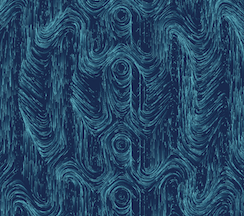Vectorflow is a tool designed for visualizing vector fields using a 2D field equation. It represents the velocity of each point in the field with a particle that traces a path. This project and guide draw inspiration from Anvaka's Fieldplay repository. The entire project is written in Rust and compiled to Web Assembly. Try it out on nyberg.dev/vectorflow/
Let's assign to every point on a grid a vector (1, 0). This means
we have an arrow, pointing to the right:
Let's pretend these vectors represent velocity. What if we drop a thousand particles onto this grid? How would they move?
When we assigned a vector to each point on the plain, we created a mathematical structure
called Vector Field.
Let's create a bit more interesting vector field:
- Points with even
ycoordinate get vector(1, 0); - Points with odd
ycoordinate get an opposite vector(-1, 0);
Again we drop a few thousands particles and see what happens:
The field above can be written in a single formula:
(
50 * (floor(y/100) % 2) - 25
,
0.0
)
The floor function effectively rounds down all y values to the nearest integer. As a result, the first 100 pixels assume the value 0, the subsequent 100 pixels take on the value 1, and so forth. By applying the modulo of 2 to these values, we obtain 0 for even numbers and 1 for odd numbers. We then manipulate this remainder to generate a final vector, which is either (-25, 0) or (25, 0).
Up until now, we've exclusively utilized one component of the velocity vector, specifically x, causing the particles to move solely horizontally. Let's experiment with configuring both components and observe the outcomes.
(
50 * (floor(y/100) % 2) - 25
,
50 * (floor(x/100) % 2) - 25
)
Wow! Two simple operations, and the final animation looks like an art piece!
Vector fields turns out to be very flexible generative framework.
The parser function utilizes the x and y coordinates as well as the distance from the origin r and the angle with the x-axis a of each pixel to compute the corresponding vector, it also has the ability to use the t variable to create time-dependent fields where t is measured in seconds, and resers every minute.
Furthermore, it offers the following functionalities:
constants:
pi // 3.141592653589793
e // 2.718281828459045
variables:
x
y
t // time in seconds
r // distance from origin
a // angle with the x-axis
Single variable functions:
sin(x)
cos(x)
tan(x)
sqrt(x) // square root
abs(x) // absolute value
sgn(x) // signum function
floor(x) // round down
ceil(x) // round up
Two variable functions:
a + b
a - b
a * b
a / b
a ^ b // power
a % b // modulo
len(x1, y2, x2, y2) // distance between two points
Here are some cool example, feel free to suggest some yourself!
Dipole
(
x*y/1000
,
(y*y - x^2)/1000
)
Swirls
(
x+r * sin(sqrt(r))
,
y+r * cos(sqrt(len(x,x)))
)
Black Hole
(
y/(r^2/100000 - 0.001*x)
,
-x/(r^2/10000 - 0.001*y)
)
Mosaic
(
10*sin(y/100 + x/1000)*t
,
10*cos(x/100 - y/1000)*t
)
Eye
(
x*cos(abs(sin(t/4))*600/r) - y*sin(abs(sin(t/4))*600/r)
,
x*sin(abs(sin(t/4))*600/r) + y*cos(abs(sin(t/4))*600/r)
)
Radar
(
-y + (1-((x*sin(t) + y*cos(t))/abs(x*sin(t) + y*cos(t))))^10*x
,
x + (1-((x*sin(t) + y*cos(t))/abs(x*sin(t) + y*cos(t))))^10*y
)










